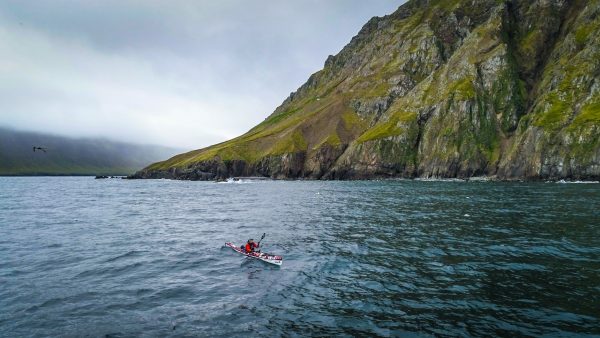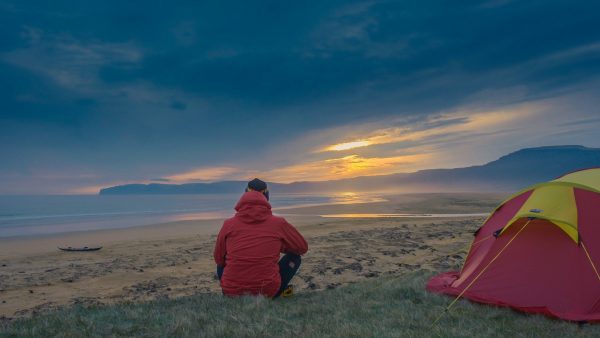
“Against the Current” (2021). Cast: Veiga Grétarsdóttir, Helga Snædel, Guoni Páll Viktorsson, Grétar S. Pétursson, Sólveig S. Kristinsdóttir, Kristinn Grétarsson, Bjarki Jónsson, Örlygur Sigurjónsson, Elín Esther Magnúsdóttir. Director: Óskar Páll Sveinsson. Screenplay: Margrét Örnólfsdóttir and Kristin Ólafsdóttir. Web site. Trailer.
To truly prove ourselves, sometimes we must pursue goals that are seriously over the top, quests that most of us would view as seemingly impossible, possibly even foolhardy. The statements such gestures make go a long way toward validating the intents behind them. But, perhaps even more importantly, they say a lot about us – who we are, what we’re championing and what we’re made of. So it was for a determined athlete who attempted something never before tried, a venture designed to prove something about herself and what she stood for, as depicted in the inspiring new documentary, “Against the Current.”
Veiga Grétarsdóttir spent many years in search of herself. This courageous transgender kayaker struggled to come to terms with her identity, a difficult task for someone trapped in a body whose physical gender did not match what was in her consciousness. She tried desperately to be the man she was born, attempting to live up to the qualities and behavior of what society expected. It was an ordeal compounded by being born into a family with two brothers, both of whom were comfortable in their own skin and urged their sibling to join them in their typical male pursuits. Veiga (born Veigar) joined them and likewise sought to engage in all of the activities that make men who they supposedly are. She openly admits to intentionally overcompensating in these activities, as if making an extra effort would somehow make a difference, a common practice among transgender individuals trying to vanquish their seemingly inexplicable contrary impulses. Veigar even went so far as to get married and have a child with his wife, Helga, believing that this was what a man was supposed to do and that it would “cure” him of these “errant” thoughts.
But, try as he might, Veigar could not fight his feelings. He felt compelled to dress in women’s clothing and to apply makeup. He would look for ways to hide his secret and to indulge these urges in private, often making excuses to his wife and family so that he could have time to be alone to pursue his impulses. However, despite the satisfaction he derived from these solitary diversions, he had difficulty reconciling his reality with his feelings. It tore him up, and he decided he had to make a change. He thus attempted suicide – twice.

Realizing that suicide was not an answer, Veigar finally recognized the need to acknowledge and accept his circumstances. With the help of a support group and friends like Elín Esther Magnúsdóttir, Veigar stepped aside to allow Veiga to come forth. She underwent the gender reassignment process and became the woman she is today.
While much obviously changed in Veiga’s new life, her old life did not completely disappear, such as her love of sport, particularly kayaking. In fact, she always dreamed of circumnavigating her native Iceland, an ambitious undertaking for anyone who has ever attempted the 2,100-kilometer journey. But Veiga’s ambition was something even more bold than the attempts made by others who undertook this venture – she wanted to go about it in a counterclockwise direction, against the prevailing current.
When asked why she wanted to undertake such an odyssey, Veiga remarked that she had been going against the current all of her life and that a journey of this nature somehow seemed aptly fitting. But there was more to it than that. Just as comedian Dick Gregory undertook prolonged fasts and long-distance runs to draw attention to causes near and dear to him, Veiga embarked on her quest to promote awareness of transgender issues. After all, as Gregory observed, once people ask why someone is engaging in extreme ventures like this, it opens the door to explaining why and thereby making the cause known, a goal comparable to what Veiga was undertaking. In addition to promoting support for the transgender community, she was also seeking to generate interest in several organizations aimed at providing assistance to those in need. She particularly sought backing for groups offering help to prevent suicides among at-risk trans individuals, a cause especially important to her in light of her own history.

After months of preparation and training, Veiga was at last ready to begin her journey. Accompanied by fellow kayaker Örlygur Sigurjónsson for the first leg of her trip, she embarked from her home port of Isafjärder on the west coast of Iceland to start what would be a 103-day endeavor. With director Óskar Páll Sveinsson in tow, the filmmaker and his crew followed Veiga on this remarkable and groundbreaking trip. Gorgeously filmed footage of her journey, intercut with segments drawing parallels between this odyssey and the one that led her to this venture, tell a compelling story of triumph, fortitude and personal growth on multiple fronts. The result is an uplifting and enlightening tale of what we can accomplish – and who we can be – when we set our minds to it.
The twin journeys examined in this film reflect the twin journeys that Veiga underwent in her life, and they mirror one another in many ways. That’s not entirely surprising, though, given that our outer world is a reflection of our inner selves, the realm of our thoughts, beliefs and intents. Those are the tools that make our existence come to life through the conscious creation process, the philosophy that maintains we manifest the reality we experience by tapping into these resources. Our existence thus becomes a materialization of what we hold most dear, and Veiga’s experience illustrates this with tremendous clarity and fidelity. Even if she never heard of this philosophy, she became a master of its principles, an accomplishment apparent in the results she attained.

In reaching this point, though, Veiga had to face a number of personal fears, serious limitations that were holding her back from achieving fulfillment in life. This required her to address these issues and examine the beliefs that were driving them. And, by being willing to confront them directly, she was able to rewrite those notions and, in turn, courageously reshape her existence. That’s quite an accomplishment in itself, but the particulars of what she did were even more impressive, given that they unfolded on multiple fronts.
To a great degree, Veiga was able to achieve this by taking a good, hard look at who she really was – on the inside. In doing so, she was able to face her truth and then live it, through her beliefs, with integrity. That proved significant, as that integrity enabled her to materialize her reality with tremendous authenticity, a result that provided her with great satisfaction.
Given the challenges Veiga took on, she came face to face with great undertakings on two fronts. In depicting these endeavors, director Óskar Páll Sveinsson described Veiga’s journey as one characterized by two classic confrontations: humanity vs. nature, as evidenced by her kayaking adventure, and humanity vs. itself, as seen in her gender reassignment odyssey. Both called for struggle and sacrifice. However, as Veiga admits, these challenges enabled her to boost her self-confidence, helping her grow more committed and courageous, skills she took with her from these experiences that she believes she will be able to draw upon in future ventures. She hopes, as I’m sure most of us would, that this development will be something she carries with her, enabling her to draw upon it when needed in subsequent undertakings. All she needs to do is believe in herself and her abilities.

With these elements in place, Veiga was ultimately able to live out her destiny. That’s something we should all hope we’re able to do, particularly when it helps provide benefits to others, a practice known in conscious creation circles as value fulfillment. By taking on these challenges, Veiga drew attention to the needs and concerns of transgender individuals, efforts that have helped lead to the betterment of the trans community. There’s a tremendous nobility to come out of that, but one that’s also characterized by a great sense of personal fulfillment and satisfaction knowing that our beliefs – and their manifestation – have really helped make a difference.
What resulted from this 103-day endeavor, as chronicled in Sveinsson’s sensitive and gorgeously filmed documentary, is a journey of self-discovery on multiple fronts – and one not limited to the waters off the coast of Iceland. The juxtaposition of the two primary story threads is perfectly balanced, showing uncanny parallels between what Veiga experienced on the ocean and what she underwent during her life onshore. In addition to footage of Veiga’s experience in both of these journeys, the film also features interviews with her parents, Grétar and Sólveig, her brother, Kristinn, her lifelong friend, Bjarki, her former wife, Helga, and kayaking experts, Guoni Páll Viktorsson and Örlygur Sigurjónsson, all of whom provide additional insights. This offering is an inspiring and uplifting piece of filmmaking, one sure to stir the spirit, tug at the heart and encourage us to fulfill potential we never knew we had. The film is currently playing in limited theatrical release and is available for streaming online.
When we succeed at proving to ourselves (and others) that we’re capable of living our personal truths, we often come away from the experience with a new sense of self, one that tends to be authentic, empowering and uplifting in many ways. Veiga Grétarsdóttir proved that to herself through her heroic journeys and to us through this film. The path to fulfillment may not have always been an easy one, but the results speak for themselves and, one would hope, help to inspire those seeking to accomplish the same.
Copyright © 2021, by Brent Marchant. All rights reserved.

No comments:
Post a Comment